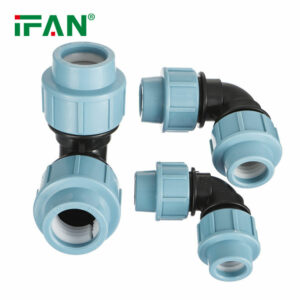Description
HDPE Pipe Fitting For Irrigation: What You Need To Know
HDPE Pipe Fitting’s Injection Workshop
The injection workshop is a vital part of the manufacturing process of HDPE pipe fittings. It is a highly automated and precise process that guarantees the quality, performance, and durability of the finished product. With the use of high-quality materials, injection molding machines, and rigorous quality control, it is possible to produce HDPE pipe fittings that are strong, durable, and built to last.
IFAN factory started in 1993. And IFAN has workshop 120000 ㎡with 610 staff. IFAN can design and produce all plumbing pipe and fitting include PPR,PVC,CPVC PPSU HDPE PEXA PEXB PERT pipe and fitting ,brass fitting, brass ball valve ,heating system , gas system , sanitary faucets and hose.The factory building area is 120 thousand square meters square,with 30 years of factory management experience. There are 610 employees and more than 50 backbone teams.
If you want to learn more information, please click here!
Types of HDPE Pipe Fittings
First, let’s talk about the different types of HDPE pipe fittings that are commonly used in irrigation systems. There are various types of HDPE fittings that can be used to connect pipes together and create complex irrigation networks. Some of these fittings include:
1. Elbows: These fittings are used to bend pipes at different angles, typically 90 or 45 degrees. They are useful in irrigation systems where pipes need to turn at corners or around obstacles.
2. Tees: These fittings are “T”-shaped and are used to connect three pipes together. They are ideal for branching out from one main pipeline to multiple irrigation lines.
3. Couplings: These fittings are used to join two pipes together. They are useful when pipes need to be extended or repaired.
4. Reducers: These fittings are used to connect pipes of different sizes together. They are useful when irrigation systems require a reduction in flow rate.
5. Valves: Valves are used to control the flow of water in an irrigation system. They can be installed in-line or at the end of a pipeline.

Materials Used
HDPE pipe fittings are made from high-density polyethylene – a plastic that is durable, flexible, and light-weight. This material is ideal for irrigation systems, as it is resistant to corrosion, weathering, and UV radiation. HDPE pipe fittings are available in different grades depending on their intended application.
Applications
HDPE pipe fittings are commonly used in irrigation systems for agricultural and landscaping purposes. They are ideal for water supply and drainage systems due to their ease of installation, flexibility, and resistance to extreme temperatures.

Unique Features
HDPE pipe fittings have some unique features that make them stand out from other pipe fitting materials. Some of these features include:
1. Corrosion resistance: HDPE pipe fittings are immune to corrosion and can withstand harsh environments.
2. Lightweight: These fittings are lightweight and easy to transport and install.
3. Low maintenance: HDPE fittings do not require regular maintenance, reducing installation and maintenance costs.
4. Flexibility: HDPE fittings can bend and flex without breaking or cracking, allowing for easy installation in tight spaces.
In conclusion
HDPE pipe fittings are ideal for irrigation systems due to their durability, flexibility, and corrosion resistance. Whether you are installing a new irrigation system or upgrading an existing one, choosing the right HDPE pipe fittings can make all the difference in your system’s performance and longevity.

Related products
-
PP Fitting 601
PP Fittings
-
PP Fitting 601
IFAN HDPE Pipe Fitting
-
PP Fitting 602
IFAN HDPE Pipe Fitting Male Socket










